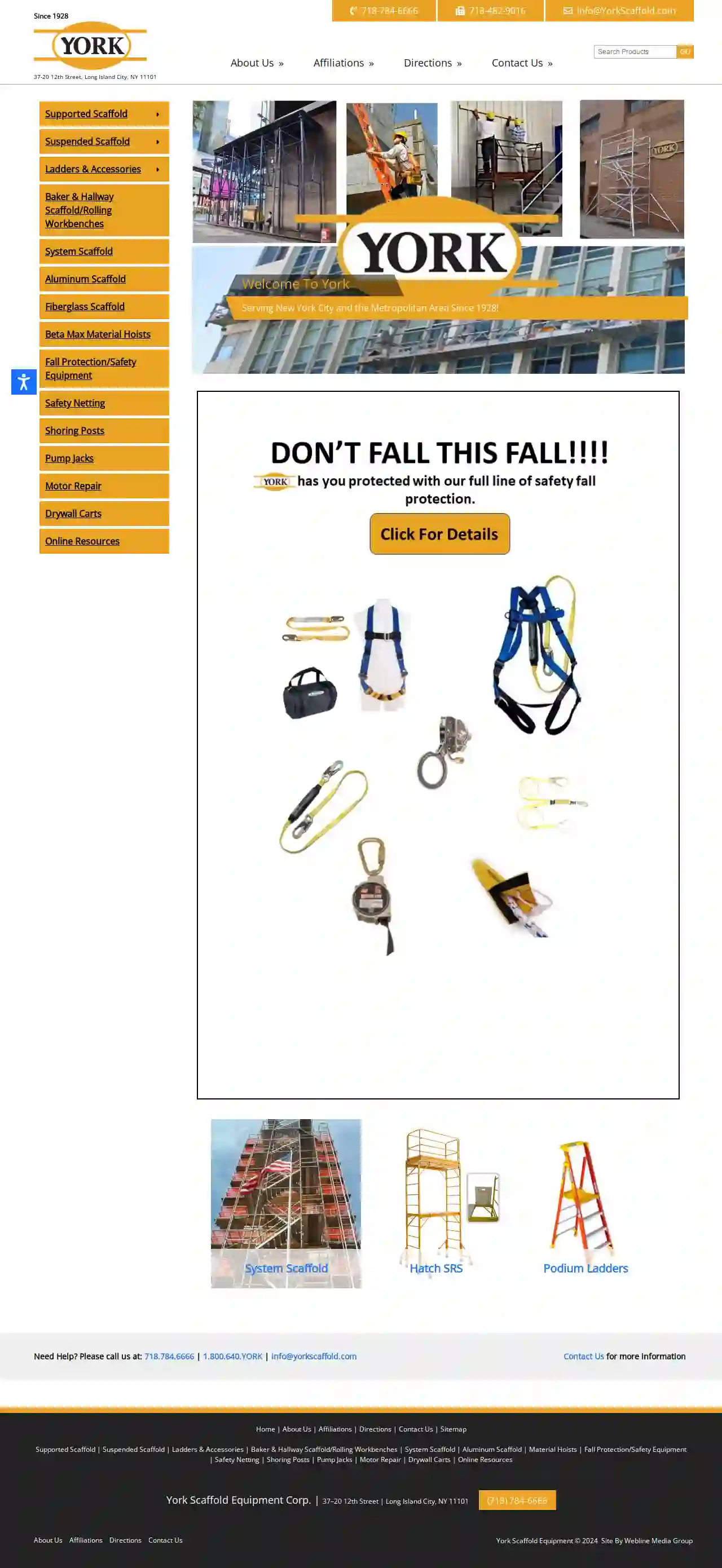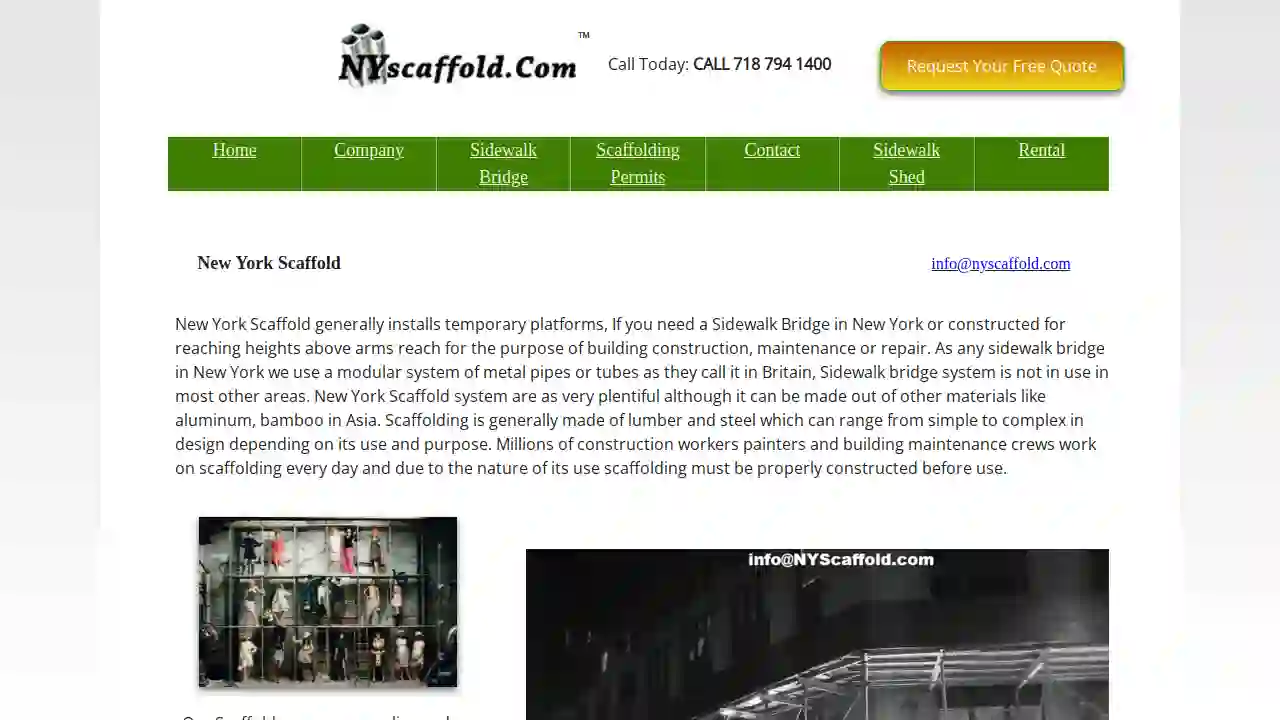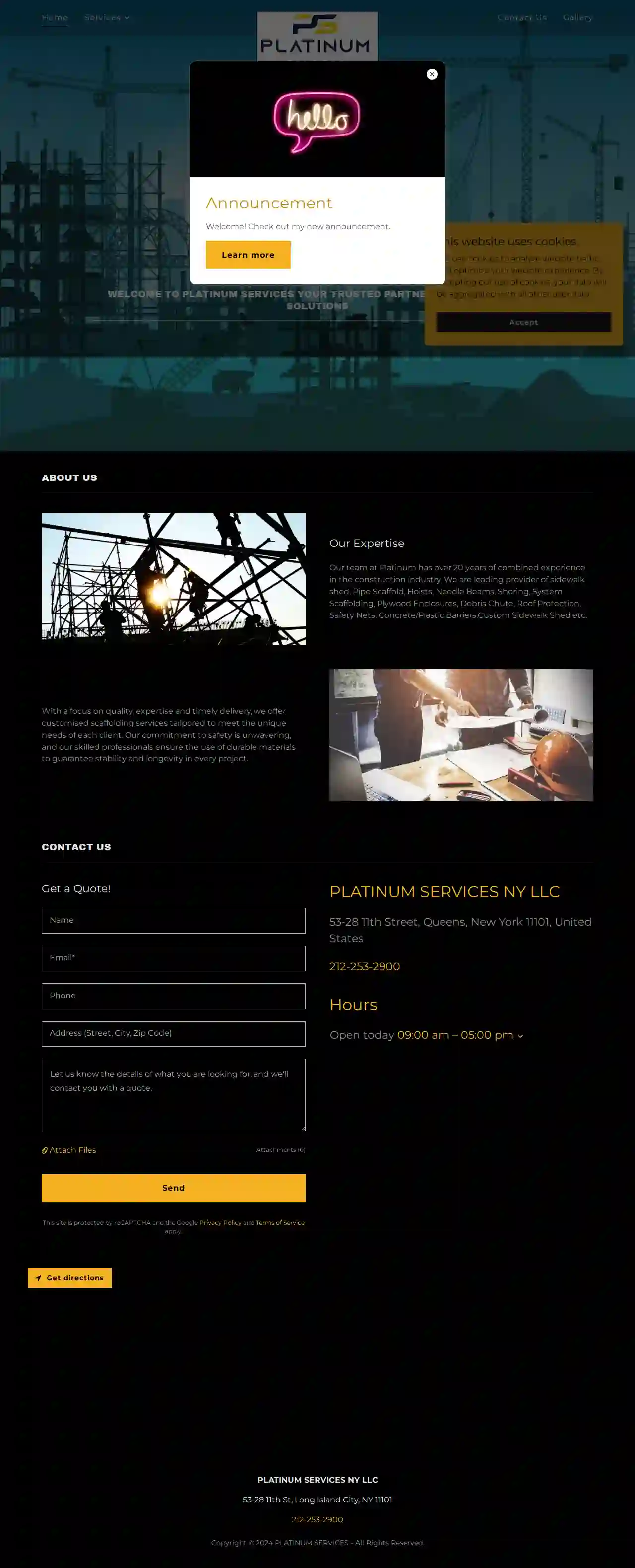Scaffolding Rental Lower Merion
Find top Scaffolding Rental in Lower Merion
Receive up to 3 Scaffolding Equipment Rental quotes for your project today! Compare profiles, reviews, accreditations, portfolio, etc... and choose the best offer.

Celtic Scaffolding Company
4.214 reviewsYork, USAt Celtic Scaffold, we specialize in providing top-notch scaffolding services to our clients in New York City. With years of experience in the industry, our team of experts is well-versed in the different types of scaffolds, including pipe scaffolds and hanging or suspension scaffolds. Our pipe scaffolds are stationary and constructed with pipes, erected from the ground up along the side of a building. We ensure that our pipe scaffolds comply with the regulations set by the Construction Division within each borough office of the Department of Buildings (DOB). On the other hand, our hanging or suspension scaffolds are supported from the roof or setback of a building and held by either cables or rope. We contract master riggers or special riggers for the work, and each worker using or operating the suspension scaffold must be employed by the master rigger, special rigger, or their company.
- Services
- Why Us?
- Gallery
Get Quote
Dynamic Hoisting & Scaffolding
54 reviews43-30 48th St, Long Island City, 11104, USAt Dynamic Hoisting & Scaffolding, we transform your vision into reality with our expertise in hoisting and scaffolding solutions. Our team is dedicated to delivering exceptional results, ensuring your projects are completed on time and within budget. Established in 2013, Dynamic Hoisting & Scaffolding is dedicated to providing high-quality construction services that exceed our clients' expectations. Our mission is to innovate, sustain, and continually improve every aspect of our work. Join us in transforming the construction landscape with our reliable scaffolding solutions. We use the highest quality materials and craftsmanship to ensure durability and excellence in every project. We conduct our business with transparency, honesty, and respect, prioritize the safety of our employees, clients, and the community, and embrace new technologies and methods to enhance efficiency and effectiveness.
- Services
- Why Us?
- Testimonials
- Gallery
Get Quote
Keystone Sidewalk Shed & Scaffolding NYC
526 reviewsNew York City, USAt Keystone Sidewalk Shed & Scaffolding, we are dedicated to providing top-quality sidewalk shed and scaffolding solutions in New York City. Our commitment to safety, efficiency, and excellence sets us apart from the rest. With over 20 years of experience, we have successfully handled numerous projects, ensuring the safety of workers and pedestrians alike. Our team consists of DOB and OSHA-certified experts who are renowned for erecting high-capacity structures that comply with OSHA regulations. We offer a wide range of services including scaffolding rental, sidewalk shed rental, Jersey barriers rental, temporary fencing rental, and rigging services. Our commitment to safety has earned us prestigious awards, making us the trusted choice for diverse project needs.
- Services
- Why Us?
- Accreditations
- Our Team
- Testimonials
- Gallery
Get Quote
Kings Group NY Corp
51 reviews120-5 Atlantic Ave, Suite #2, Richmond Hill, 11418, USAt Kings Group NY, we prioritize Safety and Quality in every project we undertake. Our mission is to ensure that our clients receive the best possible service, from the initial consultation to the completion of the project. With a team of experienced professionals, we provide top-notch scaffolding services to contractors, construction managers, developers, and building owners. Our organization is committed to meeting project budgets, schedules, and daily safety codes, and we take pride in our ability to deliver exceptional results. Our team is comprised of NYC DOB and OSHA code-certified professionals who are dedicated to providing the highest level of service. We offer a range of services, including sidewalk sheds, scaffolding, hoists, and other specialized services. Our goal is to provide our clients with the best possible experience, and we strive to exceed their expectations in every way.
- Services
- Why Us?
- Accreditations
- Gallery
Get Quote
York Equipment Corp.
4.628 reviewsLong Island City, NY, 37-20 12th Street, 11101, USYork Scaffold Equipment Corp. has been serving New York City and the Metropolitan Area since 1928. The company specializes in providing a wide range of scaffolding solutions, including supported, suspended, and system scaffolds, as well as ladders, accessories, and safety equipment. With a strong commitment to customer satisfaction and safety, York Scaffold Equipment Corp. offers top-quality products and services to meet the needs of construction and renovation projects.
- Services
- Why Us?
- Accreditations
- Our Team
- Testimonials
- Gallery
Get Quote
NY Scaffold
51 reviewsYork, USWe are national scaffold contractors and scaffolding erectors. Experienced NY Scaffold erectors can provide a range of access services for you or your clients, we also take care of any and all NYC DOB Permits. Large and small projects; industrial, commercial and domestic sectors can hire the services of NY Scaffold erectors. No job is too big or too small for us and we have grown our business in the last few years to become one of the leading erectors of scaffolding and sidewalk bridges in the NYC area. Plan your project with complete confidence the sidewalk bridge company NYC can erect scaffolding to all types of structures. NYC installs scaffolds from access towers to bridges and any other type of access equipment that your firm might require. It does not matter how big or how small your project is NY scaffold company NYC will cater to your needs. They have secure access equipment that is perfect for projects in and around the region. Our Scaffolding has several unique safety features that benefit the system’s erectors, users and project inspectors. With eight completely variable component node points and the largest available bay sizes, Our Scaffolding offers the most flexible system. Only five main components are required for basic use and the only erection tools required are a hammer and level. The system’s optimum design offers a high load rating and extreme rigidity, keeping your workers secure and productive. NY Scaffold is the leading specialty Scaffold Erector Company covering the whole of the US. We are totally focused on customer satisfaction and pride ourselves on the range of services we provide, We have 95% repeat business on an ongoing basis. NY Scaffold is fully self-sufficient and one the largest stockholders of the sidewalk bridge system within the US. This forms the basis of the NY Scaffolds motto safety speed efficiency. Our business is based around the materials that are stored in bins and are loaded by forklift in our yards and unloaded on site by our Truck mounted Booms. We deliver our scaffolding equipment to your site, and our team of experienced erectors will set it up for you, ensuring that your project is completed safely and efficiently.
- Services
- Why Us?
- Gallery
Get Quote
West New York Restoration of CT, INC
4.512 reviews1800 Boston Rd, Bronx, 10460, USWest New York Restoration of CT, Inc was founded in 1984 by Principal Alfred Gallicchio with the goal of providing high-quality contracting services in the field of exterior restoration, roofing and waterproofing. The philosophy of the company and its owner is a simple and direct one: to combine experience, management services, and skilled workforce to achieve the highest level of quality for each project. West New York Restoration of CT, Inc.'s key personnel bring a wealth of experience to each project. Whether the problem at hand concerns roofing, waterproofing, masonry, or structural repair, West New York Restoration of CT, Inc. can provide the solution.
- Services
- Why Us?
- Our Team
- Gallery
Get Quote
Platinum Services
34 reviews53-28 11th St, Long Island City, 11101, USWelcome to Platinum Services, your trusted partner in scaffolding solutions. With over 20 years of combined experience in the construction industry, our team at Platinum has the expertise to provide customized scaffolding services tailored to meet the unique needs of each client. Our commitment to safety is unwavering, and our skilled professionals ensure the use of durable materials to guarantee stability and longevity in every project. We offer a range of services, including sidewalk shed, Pipe Scaffold, Hoists, Needle Beams, Shoring, System Scaffolding, Plywood Enclosures, Debris Chute, Roof Protection, Safety Nets, Concrete/Plastic Barriers, and Custom Sidewalk Shed. Contact us today to get a quote and learn more about our services.
- Services
- Why Us?
- Gallery
Get Quote
LMB Industrial Services, Inc.
52 reviewsP.O. Box 606, Birdsboro, 19508, USLMB Industrial Services, Inc. is a one-stop shop for reliable, affordable, on-time refractory, scaffolding, robotic demolition, and mechanical services. Founded in 2007, the company's vision is to be the best refractory engineering company/contractor in the US. With a 97% customer retention rate, LMB focuses on five key pillars of success: safety, on-time delivery, quality, price, and experience. The company's team members are trained to uphold the same values and standards as project managers, ensuring superior quality in every project. LMB provides fair and honest assessments of projects, avoiding lowballing upfront costs and backloading with extras. The company's administrative office and warehouse are located in Birdsboro and Pottsville, PA, respectively.
- Services
- Why Us?
- Accreditations
- Gallery
Get Quote
NY Scaffolding
York, USNY Scaffold is a leading national scaffold contractor and scaffolding erection company. We specialize in providing a range of access services for both commercial and residential projects throughout the US. We are fully focused on customer satisfaction and pride ourselves on the range of services we provide. We have a 95% repeat business rate, a testament to our commitment to quality and reliability. NY Scaffold is fully self-sufficient and one of the largest stockholders of the sidewalk bridge system in the US. This forms the basis of our motto: safety, speed, and efficiency. Our business is built on providing high-quality scaffolding and sidewalk bridge solutions, ensuring the safety and productivity of our clients' projects. We offer a comprehensive range of services, including: Scaffolding Erection and Dismantling Sidewalk Bridge Installation and Removal Scaffolding Permits Shoring Hoisting Construction Fencing Our team of experienced scaffold erectors is dedicated to providing safe, efficient, and reliable service. We utilize the latest equipment and techniques to ensure that all projects are completed to the highest standards. Whether you need scaffolding for a small residential project or a large commercial construction site, NY Scaffold has the expertise and resources to meet your needs. Contact us today for a free quote and let us help you take your project to new heights.
- Services
- Why Us?
- Gallery
Get Quote
Over 2,353+ Scaffolding Businesses on our platform
Our scaffolding companies operate in Lower Merion & beyond!
ScaffoldingHQ has curated and vetted the Best Scaffolding Contractors arround Lower Merion. Find a top & reliable contractor today.
Frequently Asked Questions About Scaffolding Rental
- Stop Using It Immediately: Do not attempt to use damaged scaffolding. It could be unsafe.
- Contact the Rental Company: Notify the scaffolding rental company about the damage as soon as possible.
- Document the Damage: Take photos or videos of the damage for documentation. The rental agreement should outline the procedures for handling damaged equipment. You may be responsible for repair or replacement costs, depending on the circumstances and the terms of the agreement.
- All Components: Ensure all the necessary components (tubes, clamps, boards, braces, etc.) are present and in good condition.
- Damage or Defects: Look for any signs of damage, rust, or defects on the scaffolding parts.
- Scaffolding Tag: Verify that the scaffolding tag is up-to-date and shows the last inspection date.
- Safety Features: Check that guardrails, toeboards, and other safety features are included and in working order.
- Construction: Building new structures, adding extensions, and performing facade work.
- Renovation and Repair: Repairing or replacing roofs, siding, windows, and gutters.
- Maintenance: Cleaning windows, painting, and performing general upkeep on buildings.
- Industrial Work: Accessing elevated equipment, performing inspections and repairs on industrial structures, and carrying out construction work in industrial settings.
- Events: Creating temporary stages, grandstands, and platforms for concerts, festivals, and sporting events.
- General Liability Insurance: Provides coverage if someone is injured or property is damaged due to your use of the scaffolding.
- Worker's Compensation Insurance (if you have employees): Covers medical expenses and lost wages for employees injured while working on the scaffolding.
What happens if the scaffolding is damaged during my rental period?
What should I check for when the scaffolding is delivered?
What is scaffolding used for?
Do I need insurance to rent scaffolding?
What happens if the scaffolding is damaged during my rental period?
- Stop Using It Immediately: Do not attempt to use damaged scaffolding. It could be unsafe.
- Contact the Rental Company: Notify the scaffolding rental company about the damage as soon as possible.
- Document the Damage: Take photos or videos of the damage for documentation. The rental agreement should outline the procedures for handling damaged equipment. You may be responsible for repair or replacement costs, depending on the circumstances and the terms of the agreement.
What should I check for when the scaffolding is delivered?
- All Components: Ensure all the necessary components (tubes, clamps, boards, braces, etc.) are present and in good condition.
- Damage or Defects: Look for any signs of damage, rust, or defects on the scaffolding parts.
- Scaffolding Tag: Verify that the scaffolding tag is up-to-date and shows the last inspection date.
- Safety Features: Check that guardrails, toeboards, and other safety features are included and in working order.
What is scaffolding used for?
- Construction: Building new structures, adding extensions, and performing facade work.
- Renovation and Repair: Repairing or replacing roofs, siding, windows, and gutters.
- Maintenance: Cleaning windows, painting, and performing general upkeep on buildings.
- Industrial Work: Accessing elevated equipment, performing inspections and repairs on industrial structures, and carrying out construction work in industrial settings.
- Events: Creating temporary stages, grandstands, and platforms for concerts, festivals, and sporting events.
Do I need insurance to rent scaffolding?
- General Liability Insurance: Provides coverage if someone is injured or property is damaged due to your use of the scaffolding.
- Worker's Compensation Insurance (if you have employees): Covers medical expenses and lost wages for employees injured while working on the scaffolding.